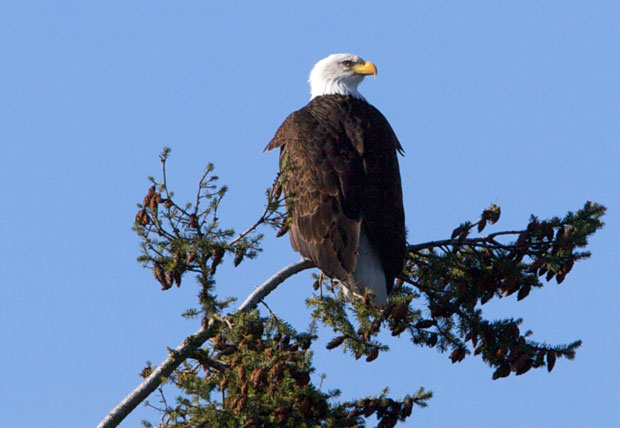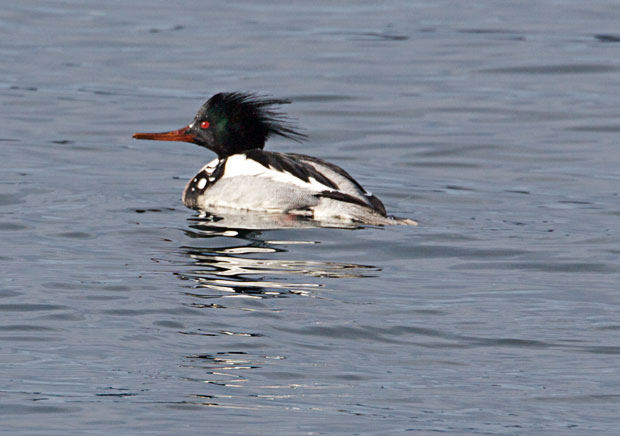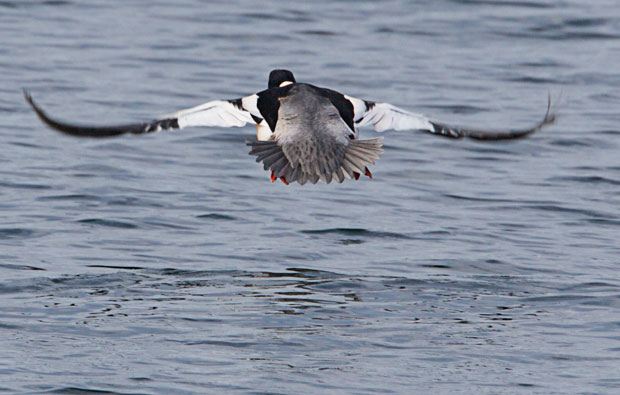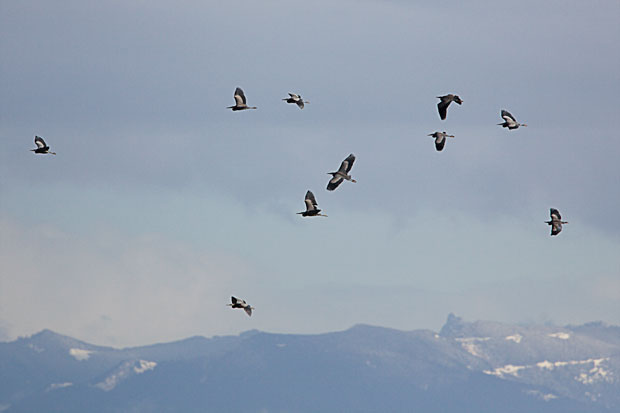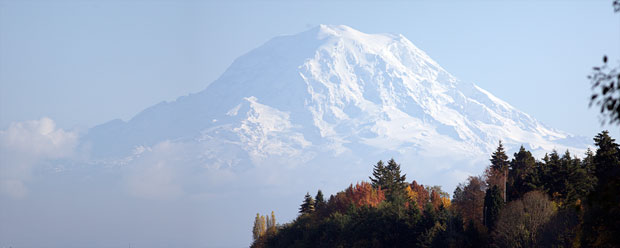I’ll have to admit that I had some major reservations about Peter Matthiessen’s character as I read The Snow Leopard. While I gave him credit for not trying to gloss over his faults, I had a particularly hard time identifying with his actions in the beginning of the book. My greatest criticism is perhaps a personal one, but I found it particularly cold-hearted to leave his eight year old son alone shortly after his mother’s death. Of course, as narrator he could have simply left out this fact, but he seems determined to portray his actions honestly. He quotes a letter from his “sun’s” letter just as the journey begins, followed by this recollection:
I think of the parting with my sun on the day that school had opened, just a month before, a clear morning of September, of monarch butterflies and goldenrod, late roses, shining pine needles, of flights of cormorant headed south along the coast in a dry east wind. Alex asked how long I would be gone, and when I told him, blurted out, “Too long!” I had driven him to school, and he was upset that he might be seen in tears. “That’s much too long,” he wept, and this was true. Hugging him, I promised to be home before Thanksgiving.
As a teacher and as one who made considerable personal sacrifice for my kids after my divorce, I could never imagine doing this to a child, not that soon after his mother’s death.
My opinion of Matthiessen didn’t improve with his revelation of his and his wife’s use of LSD when they had three kids to raise:
And yet, and yet . . . an “I” remained, aware that something-was happening, aware even that something-was-happening because of drugs. At no time did the “I” dissolve into the miracle.
Mostly D went on long, gray journeys, plagued by fear of death. I had bad trips, too, but they were rare; most were magic shows, mysterious, enthralling. After each-even the bad ones-I seemed to go more lightly on my way, leaving behind old residues of rage and pain. Whether joyful or dark, the drug vision can be astonishing, but eventually this vision will repeat itself, until even the magic show grows boring; for me, this occurred in the late 1960’s, by which time D had already turned toward Zen.
Now those psychedelic years seem far away; I neither miss them nor regret them. Drugs can clear away the past, enhance the present; toward the inner garden, they can only point the way. Lacking the temper of ascetic discipline, the drug vision remains a sort of dream that cannot be brought over into daily life. Old mists may be banished, that is true, but the alien chemical agent forms another mist, maintaining the separation of the “I” from true experience of the One.
Though I’ll admit that LSD actually seemed the most appealing of drugs because it was widely used by some very famous artists who claimed that it opened up new horizons to them, I had the questionable privilege of watching military films showing the effects of LSD on troops, and I would never have taken the chance of using LSD after I had a family. Of course, I’m am pretty conservative when it comes to drugs, limiting myself to legal drugs like alcohol and cigarettes, perhaps because I found them both too enjoyable for my own good. I was never really tempted to try illegal drugs.
Perhaps the most amazing thing about this work is that despite Matthiessen’s willingness to reveal his faults I could identify with him by the end of the book. One of the ways he manages to do this is through his identification with Tukten, one of the party’s guides that he seems to have a special link with:
Tukten has elf’s ears and a thin neck, a yellow face, and the wild wise eyes of a naljorpa, or Tibetan yogi. He radiates that inner quiet which is often associated with spiritual attainment, but perhaps his attainment is a dark one. The other Sherpas are uneasy with him; they mutter that he drinks too much, uses foul language, is not to be trusted. Apparently he has demeaned himself by taking this job as a porter. Yet they defer to him as if he possessed some sort of magic, and sometimes I think I feel his power, too.
This disreputable fellow is somehow known to me, like a dim figure from another life. Tukten himself seems aware that we are in some sort of relation, which he accepts in a way that I cannot; that he is not here by accident is, for me, a restless instinct, whereas he takes our peculiar bond for granted. More often than I like, I feel that gaze of his, as if he were here to watch over me, as if it were he who had made me cut that stick: the gaze is open, calm, benign, without judgment of any kind, and yet, confronted with it, as with a mirror, I am aware of all that is hollow in myself, all that is greedy, angry, and unwise.
Matthiessen’s identification with this “disreputable fellow” is a critical element of The Snow Leopard, though I certainly didn’t realize it until much later in the work. Tukten seems to serve as a “mirror” for Matthiessen.
Later Matthiessen says he sees a “crazy wisdom” in Tukten:
“Dolpo village many smelly, sah,” says Tukten, the only man among us who has been there: one senses that, in one life or another, he has been everywhere on earth. Of his wide experience, Tukten tells tales in that soft voice, and so the other Sherpas listen, but he is not one of them. Ordinarily Tukten would remain among the porters who have taken shelter in a cave down in the canyon, but he is helpful and ingenious, and his mesmerizing voice, coming and going on the wind and rain, seems to fascinate the younger Sherpas, although they are wary of him, and keep their distance. One feels they are afraid of him-not of his violence, though they say he fights when drunk, but of his power. Whatever this man is-wanderer or evil monk, or saint or sorcerer-he seems touched by what Tibetans call the “crazy wisdom”: he is free.
Though Matthiessen never truly explains this “crazy wisdom,” he seems to equate it with belonging to the natural world and with being free of civilization’s artificial restraint on our true nature. Although this identification with Tukten largely remains in the background, it becomes more and more prominent as the work comes to a close.
By the end Matthiessen has come to se Tukten as his guide to this world:
In the rear window of the cab, Tukten is ghostly; I stare after him as he withdraws into the dusk. It is not so much that this man and I are friends. Rather, there is a thread between us, like the black thread of a live nerve; there is something unfinished, and he knows it, too. Without ever attempting to speak about it, we perceive life in the same way, or rather, I perceive it in the way that Tukten lives it. In his life in the moment, in his freedom from attachments, in the simplicity of his everyday example, Tukten has taught me over and over, he is the teacher that I hoped to find: I used to say this to myself as a kind of instinctive joke, but now I wonder if it is not true. “When you are ready,” Buddhists say, “the teacher will appear.” In the way he watched me, in the way he smiled, he was awaiting me; had I been ready, he might have led me far enough along the path “to see the snow leopard.”
Out of respect, I stand in the same place until Tukten is out of sight. The Hindus dart off with my backpack, sleeping bag, and rucksack, and for a moment I am all alone on the hotel steps. Off to the north, black clouds are shrouding the black mountains; it is snowing. I wonder if GS has left the Crystal Mountain. Here I am, safely returned over those peaks from a journey far more beautiful and strange than anything I had hoped for or imagined – how is it that this safe return brings such regret?
In the end of the book, Matthiessen goes for one final meeting with Tukten before returning to the States and finds that Tukten has disappeared and no one has ever heard of him, an ending which reminded me a little too much of Carlos Castaneda’s The Teachings of Don Juan, a work Matthiessen refers to at one point in The Snow Leopard.
Like this:
Like Loading...


